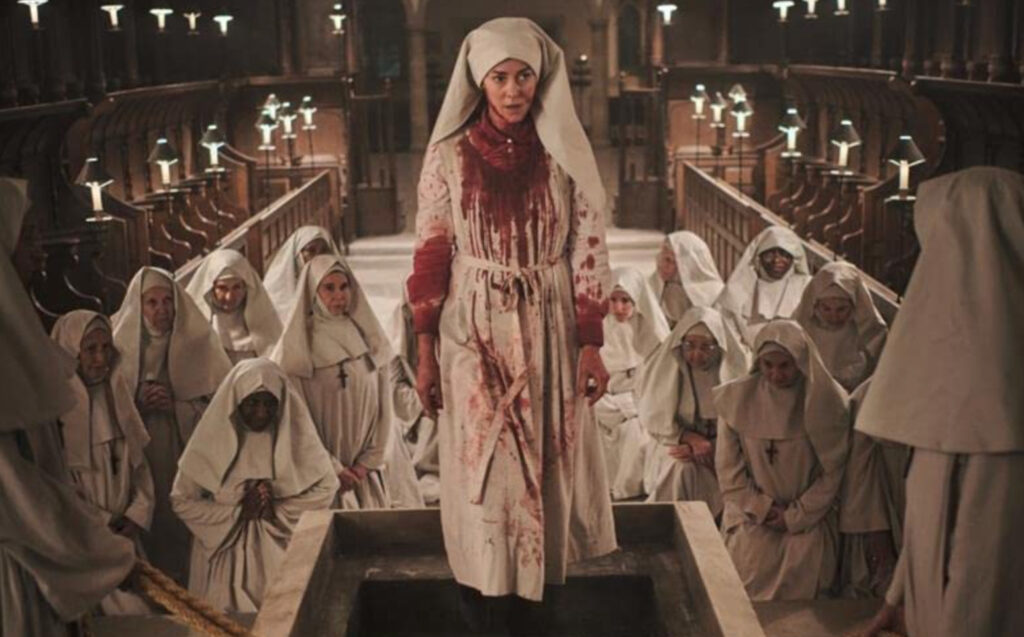“Consecration” is an Unholy Premise with an Uneven Execution

Few archetypes carry as much cultural weight as the nun. Though a relative rarity in the horror genre, the image of a woman of the cloth has been used to great advantage in films like The Devils, The Exorcist III, and Mrs. 45. The newest film to tackle this holy iconography is Christopher Smith’s Consecration, a ghostly tragedy that asks us to redefine our understanding of good and evil. The story of two adult siblings trying to save each other against a backdrop of toxic faith promises exciting empowerment, but a few key stumbles make it difficult to ever fully buy into the supernatural premise. Set in a Scottish convent, Smith makes the most of a spooky setting. A unique premise, but an uneven execution cuts the knees out from under the narrative leaving us with a religious ghost story that feels by turns both terrifying and silly.
Grace (Jena Malone) is a young ophthalmologist willing to go great lengths to help her patients. We learn in an introductory scene that she is not religious, but that her brother has always believed she has a guardian angel. This assertion of divine protection is followed by a nun approaching Grace with a raised gun, establishing the kind young woman as a threat to the faith. After learning of her brother’s death, Grace travels to a convent in rural Scotland to determine if the young priests actually died by suicide or if her suspicions of murder are true. While trying to unravel the mystery, Grace is pulled into a world of religious fanaticism that will cause her to reexamine everything she’s been brought up to believe.
The concept of Consecration is a good one. Grace is a combative fish out of water trapped in a convent after a lifetime of religious persecution. Flashbacks to her childhood show horrific abuse at the hands of her overzealous father and add context to her desperate desire to keep her brother safe. The guardian angel mentioned in the opening scene seems at times like a more menacing presence, constantly shadowing Grace as she tries to make sense of her place in the world. Without giving away the film’s twist ending, Grace is thrust into a world she hates, but finds herself slowly won over by a growing sense of hopelessness and inevitability. A shocking yet empowering ending is sure to resonate with anyone who has ever questioned their faith or found it difficult to trust representatives of organized religion.
It doesn’t take much to make a cavernous convent spooky and Smith uses the gorgeous setting to his advantage. Rocky cliffs and a jagged garden gate are the perfect setting for a religious mystery and the creaking convent is an ideal place to house a malevolent ghost with unclear motives. Clever use of mirrors and doorways lead us further into the mystery and keep us from ever acquainting ourselves with the intimidating setting. Smith dresses his nuns in all white, breaking the cinematic tradition of sisters of the cloth in black habits. Combined with the knowledge that this particular sect is known for its zealotry keeps us guessing at the intentions of Mother Superior and her Sisters.
The visual surface of the film is stunning, but a few missteps make it difficult to buy in. Jena Malone gives a heartfelt performance as a grieving sister disgusted with the church and her brother’s lifetime commitment, but she never seems to find her footing with the British accent. While this may be a small issue in a more robust cast, as the anchor of the film, her speech is a constant distraction. Danny Huston is engaging as Father Romero, a figure from Grace’s past who seems to honestly want to help. Unfortunately a somewhat clunky script has him deliver soothing platitudes to Grace one minute then berate the nuns with demands for godlike worship the next. While this juxtaposition does fit the plot, the narrative shifts so wildly that it’s difficult to take any of it seriously. Another scene sees him torturing an unfortunate young man and demanding the nuns add more weight to the planks on top of his body. They respond by stoically jumping up and down on the boards, an act that is horrific in concept, but unintentionally silly in execution.
Unfortunately there are just too many elements of the story that don’t make sense. The entire plot is built around an artifact hidden deep within the convent, but the origin of this treasure and its relationship to the convent is muddled. Bizarre flashbacks show us bits of the story, but not enough to build a cohesive narrative and what should be daming feels more like a confusing jumble. Much of the film’s marketing features Malone in a blood-soaked habit and the film’s shocking conclusion makes wonderful use of this haunting imagery. Unfortunately it feels like the entire plot has been building to this moment and some of the roads we’ve taken to get here feel flimsy at best.
The world of religious horror is a vast ocean of possibilities both profane and pious. Consecration dips its toes into this pool, but falters with the details of the story it’s trying to tell. The film’s climax packs a powerful punch, but later reflection will likely leave viewers stumbling over jarring plot holes and inconsistencies. What does work is a growing sense of inevitability and shocking scenes of faith-based horror. For all of its misfires, Consecration succeeds in theory with a haunting premise that may leave many believers hesitant to go back to Mass.
Jenn Adams is a writer, podcaster, and film critic from Nashville, TN. Find her social media nonsense @jennferatu.